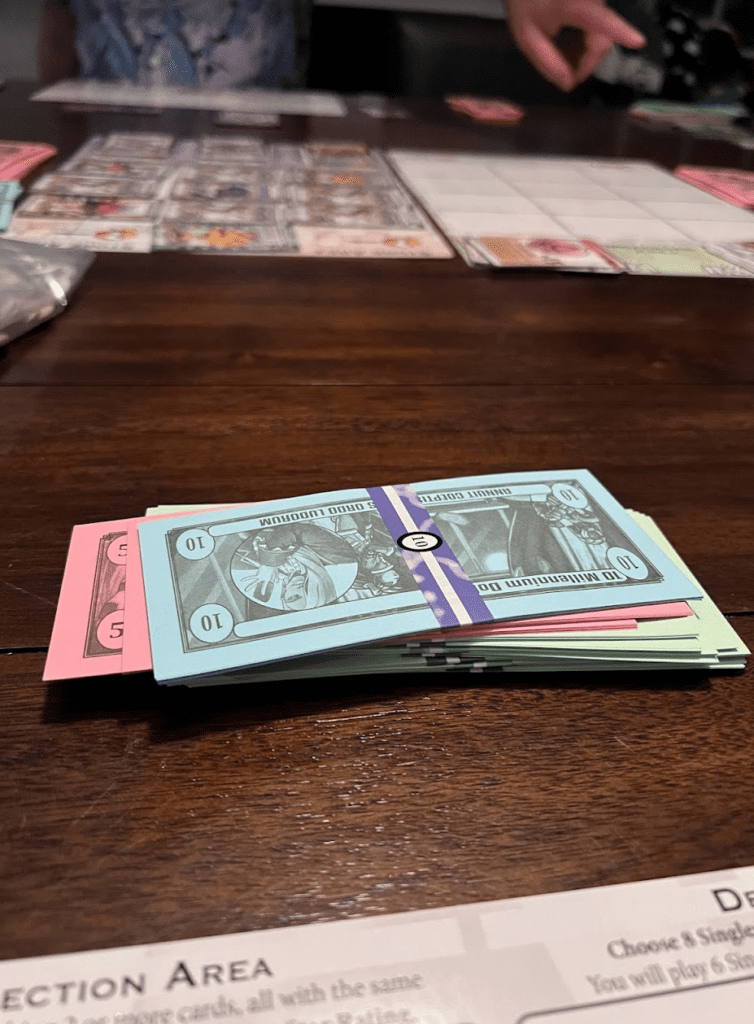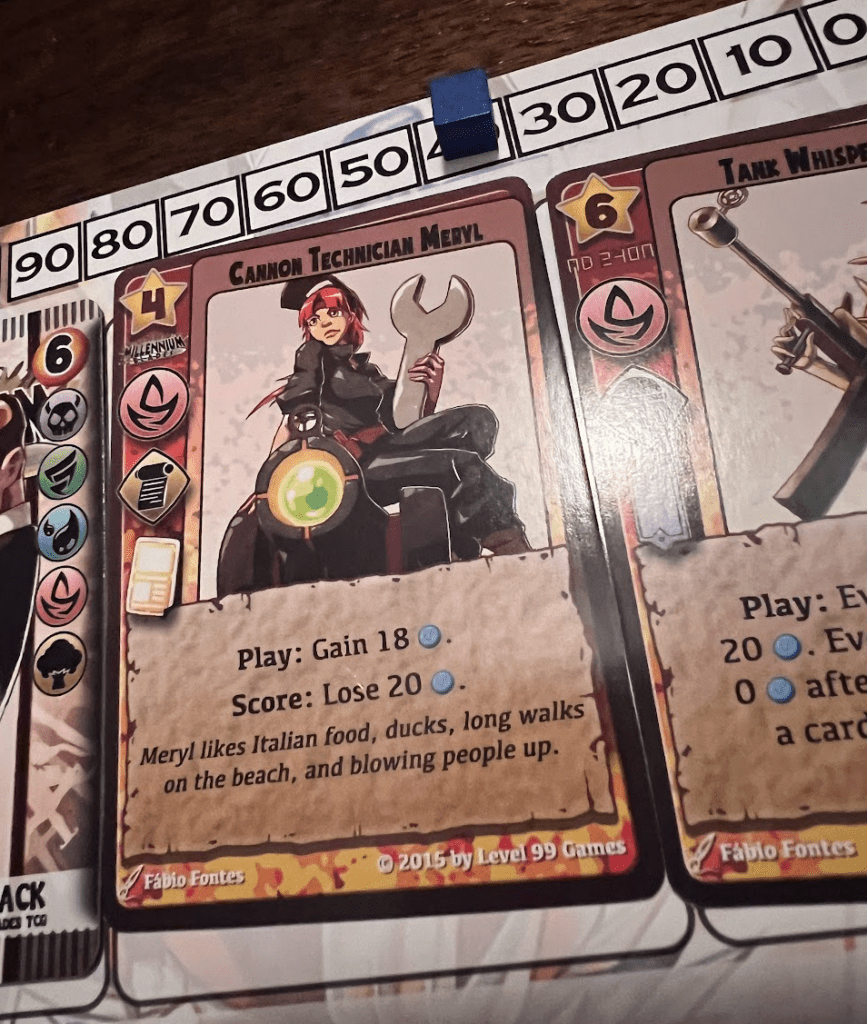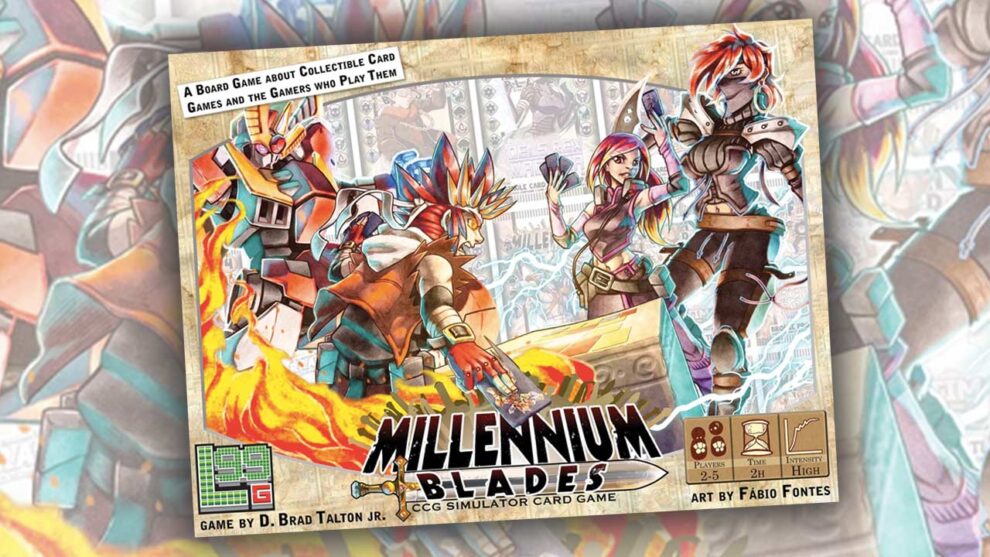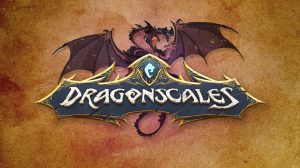Into the Metaverse
If you’re anything like me, you’ve dabbled in the Collectible Card Game (CCG) world at some point. Whether it’s Pokémon, Magic: the Gathering, the newly-released Disney Lorcana, or any number of the hundreds of other CCGs on the market, it’s not uncommon for board game enthusiasts to wind up with a passing interest in CCGs at some point. For those unfamiliar with the typical experience, it goes a little something like this: you buy packs of random cards to rip open in hopes of finding a super rare card, you build a deck of cards from the random cards you open, and you go to tournaments or game nights where you do battle against others with your deck. Of course, that’s only one aspect of the hobby. Some people are collectors who just like to collect everything; others use the hobby to make money by selling individual cards to game stores; and some just like the art and the theme.
Millennium Blades is a hilarious love letter to CCGs and nerd culture at large. The experience is so heavily defined by typical CCG tropes and experiences that I would wager it’s hard to get the whole experience of this game if you’ve never dabbled in those worlds. This game is explicitly tied to its theme, and divorcing mechanics from the theme is nigh impossible. The various “expansion sets” present in the game are riffs on everything from Looney Tunes to Firefly to Super Mario Bros to anime. There are over 600 cards in this box. Each one has been lovingly crafted and, for our playthroughs, elicited belly laughs from almost everyone at the table upon reading them and understanding the references. Most board games that attempt to be funny tend to fall flat for me, but y’all, Millennium Blades is downright hilarious.

The central conceit of Millennium Blades is that you, the real-life players, are all players of a megapopular CCG set in a universe just off-kilter from our own. The game not only captures the actual playing of the CCG but also strives to capture the whole experience of being a CCG player. You’ll chase the meta and switch up your deck, trade with friends to get the cards you need, snatch up aftermarket cards that have been sold to the store, and rip open “packs” of cards in search of that holy grail super rare, such as “James Bomb” from the “006 Plus One” expansion (I told you, this game is hilarious). You will build a pool of cards that is downright absurd (picking different “expansion” sets at the start, you’ll wind up combining 14 different piles of cards to form the pool) and then make The Friend With The Biggest Hands shuffle the gigantic pile together. This game bites off a lot, trying to be both a fully functional CCG and a compelling board game experience about trading and set collection. Do its attempts to smash those two together work like PB&J or more like oil and water? The answer is… both!
Wheeling and Dealing
The deckbuilding phase is the first phase in Millennium Blades. Everyone starts with a starter deck and gets some money to spend, plus six random cards from the comically large Store deck. Then, you set a seven-minute timer and are off to the races. That’s right–the deckbuilding phase is entirely in real-time. All players around the table frantically begin assembling their decks. There are many options for what to do during this phase, but buying face-down cards as “packs” from the store is the primary way to grab new cards. Ten cards are available for purchase anytime, but you’ll only see the back of them, gaining limited information about their expansion set and what types/elements are present across all cards in that set. This is important because different metagames are prioritized during each tournament, giving you bonus points for playing cards containing a specific element and type. The only way to buy face-up cards is in the Aftermarket, where players can sell unwanted cards at any point to get a quick cash infusion to enable their degenerate gambling on the pack ripping.

Other than buying and selling cards for your deck, there are other ways to leverage those bulk junk cards cluttering your binder. The first is to “fuse” cards to get ultra-special promo cards. These promo cards are super powerful cards, usually worth building your entire deck around. Fusing means taking several cards (five, seven, or nine) from your collection and removing them from the game to draw the top card of the fusion deck. You can also set up your “collection” for the round, playing different cost cards with one type or element in common, and you will score Victory Points at the end of the Deckbuilding phase based on your collection’s size.
And, of course, what would a meta CCG simulator game be without the ability to trade cards with other players? You can skip the Aftermarket altogether and make trades with players as long as the value of the exchange (card value + cash) is equal on both sides. That means I can offer you a two-value card and four bucks in exchange for a six-value card. However, some trades will benefit one side over the other. You may not care about my two drop because it doesn’t help your strategy, while I’m desperate for that six drop that will synergize well or finish off my collection. This is where you can offer “friendship,” aka Victory Points. Each player starts with six friendship cards they can give away to sweeten the deal, and people will score points at the end of the game for each friendship card they obtain through trades.
Once seven minutes are up, you’ll reveal another “meta” card, showing the other symbol that will score extra points in the tournament. And then you’ll put another seven minutes on the clock and go again. Once those seven minutes are up, the store will be closed to further sales, and you’ll have a final six-minute clock to finalize your deck and collection for the round. Once that’s up, players are locked into their decks, and we go to the tournament phase.
It’s Time to Duel
In the tournament phase, the real-time timers go away, and the game shifts to a slower turn-based style of play. Each player deploys their “deck box” and “accessories” to start. Players can acquire these unique cards that give you static bonuses during the tournament. Usually, your deck box will provide a scoring bonus if your tableau meets certain conditions by the end of the tournament, and your accessories will give one-time use actions or reactions. On each turn, players must play a card from their hand to the tableau and can optionally take an action if one is available. When taking an action, that card flips face-down, meaning it doesn’t count for buffs, bonuses, or scoring conditions. Cards can have various effects, such as on-play triggers, ongoing effects that keep working as long as the card remains face-up, or score effects that let you score additional Ranking Points at the end of the tournament (again, so long as they remain face-up).

There are an overwhelming number of cards in any game of Millennium Blades, probably by design. There are obvious synergies and strategies you can pull off within the decks. Some decks want their cards flipped to trigger powerful flip effects and don’t care about scoring out. Other decks want to play cards of the same type or element to trigger bonus scoring effects at the end. In our first game, it was pretty unclear how the synergies worked. By the end of the third game, it revealed that the actual CCG portion of Millennium Blades had a bit more depth underneath the surface than it appeared at first glance. It’s undoubtedly no Magic: the Gathering, but it’s also not just window dressing.
One by one, players will choose cards to play. Many cards directly interact with other players, causing them to lose Ranking Points or force them to discard or flip cards in their tableau face down. Once all players have played to all available spots on their tableau (usually six), they must pass. If everyone passes in succession, the tournament is over. Score the points and determine the winner, then assign Victory Points based on placement. The winner also gets a shiny promo card as prize support, giving them access to even more powerful cards as the game heads into the next deckbuilding phase.
Metagame Mastery
After three phases of deckbuilding and tournament play, the game ends. Players will tally their score by adding their collection Victory Points from the three deckbuilding rounds, their tournament Victory Points based on placement in the three tournaments, their total Victory Points from friendship cards obtained via trades, and finally, players score one additional Victory Point for every four dollars they have at the end of the game. If there’s a tie, there are a series of tiebreaker checks (tournaments > collections > money > friendship) to resolve it.
Millennium Blades is a strange beast of a game. I laughed out loud so many times as people read their cards aloud. It’s certainly a test of mental dexterity during the deckbuilding phase, as you have to juggle the time crunch and competing priorities in front of you. In short, it’s utter chaos. That can be fun for some, but others may wind up caving from the pressure. From a practical standpoint, this leads to a mess on the table as people scramble to buy cards, toss money into the bank, or trash cards back to the box. I would often look up from my hand and find piles of cards or cash sitting in front of me, requiring us to pause the timer and figure out whether they belonged to someone or went to the bank. We don’t play on a small table, either. This behemoth takes up a LOT of table space for a game that’s just some playmats and cards. That being said, I believe that’s part of the charm. The “messy table covered in stacks and piles of various trading cards” effect accurately reflects the nights spent at my kitchen table with friends, ripping open packs and trying to assemble decks. As I said at the start, this game is a very specific love letter to one very specific experience.

However, if you don’t have a frame of reference for that, I worry the game can come off as too chaotic and random. The actual tournament portion of the game drags a bit, and it can take several plays to start to see the deeper strategy unveil itself. If you’re not the target audience for the humor or the tropes/meta references, I’m not convinced the rest of the game underneath it all is strong enough to carry a new player experience. I’m also not the type of player who wants to play the same board game over and over again to understand the experience. I like knowing what I’m getting into after a play or two. With Millennium Blades, the sheer scope and expansiveness of the cards and sets make it impossible to grasp the depth and strategy entirely after only one game. And that’s not to mention special character powers, promo cards, an optional draft mode, and other variants.
One thing I am sure of, though, is that Millennium Blades stuck with me after playing it. On the drive home from a friend’s house recently, my husband and I ran through all the possibilities with the game and talked about things we might try in our next run-through. It may not be for everyone, but for this aging, recovering CCG addict, it’ll definitely be seeing more time on my table in the near future.











I like L99. The first thing I ever saw in Meeple Mountain was Board Game Brody’s box opening for Empyreal.
L99 seem to really know what they are doing. And they do it with a flare. Empyreal remains one of my favorite games of all time. But thus far, nothing else they have done has captured my heart the same way. I think this one is another that remains outside of my ability to get into it.
Great review! Thanks for all you do.